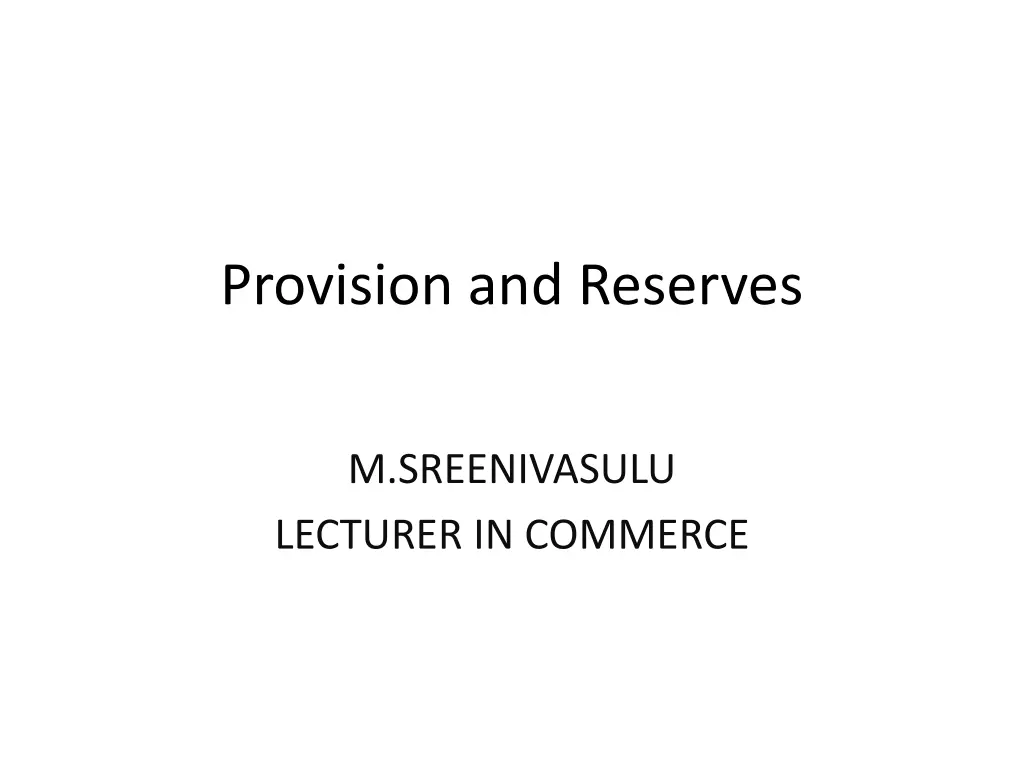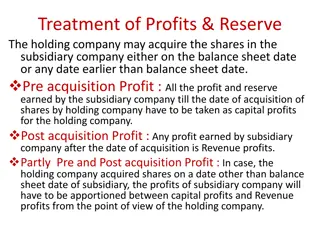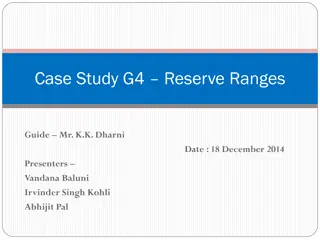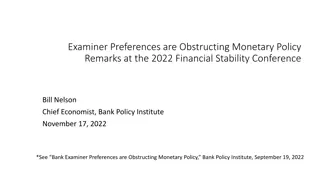
Understanding Provisions and Reserves in Accounting
Learn about provisions and reserves in accounting, including their definitions, differences, and types. Explore how reserves strengthen a company's financial position and how provisions serve specific purposes. Distinguish between reserves and provisions to enhance your financial knowledge.
Download Presentation

Please find below an Image/Link to download the presentation.
The content on the website is provided AS IS for your information and personal use only. It may not be sold, licensed, or shared on other websites without obtaining consent from the author. If you encounter any issues during the download, it is possible that the publisher has removed the file from their server.
You are allowed to download the files provided on this website for personal or commercial use, subject to the condition that they are used lawfully. All files are the property of their respective owners.
The content on the website is provided AS IS for your information and personal use only. It may not be sold, licensed, or shared on other websites without obtaining consent from the author.
E N D
Presentation Transcript
Provision and Reserves M.SREENIVASULU LECTURER IN COMMERCE
Meaning of Provisions Any amount written off or retained by the way of providing depreciation or diminution in the value of assets or for providing any known liability of which the amount cannot be determined with substantial accuracy. - The Institute of Chartered Accountants of India Liabilities which can be measured only by using a substantial degree of estimation. - AS-29 issued by Institute of Chartered Accountants of India AS 29 also defines liabilities as a present obligation of the enterprises arising from past events, the settlement of which is expected to result in an outflow from the enterprise of resources embodying economic benefits. Debiting Profit and Loss account, provisions are created and shown either deducting assets side or on the liabilities side under relevant sub-head of Balance Sheet. Provision for bad and doubtful debts, Provisions for Repair & Renewals, and Provision for discounts & depreciation are the most common examples.
Meaning of Reserves That portion of earnings, receipts or other surplus of an enterprise (whether capital or revenue) appropriated by the management for general or a specific purpose other than a provision for depreciation or diminution in the value of assets or for a known liability. -ICAI Reserve is an appropriation of profits; on the other hand, Provision is a charge against profit. Reserves are not meant to meet out contingencies or liabilities of a business. Reserve increases working capital of a company to strengthen the financial position.
There are two types of reserves Capital Reserve Capital reserve is not readily available for distribution as the dividends among the shareholders of the company, and it creates only out of capital profit of the company. It is like Premium on issue of shares or debentures and Profit prior to incorporation. Revenue Reserve Revenue reserves are readily available for the distribution of profit as dividend to the shareholders of the company. Some of the examples of this are general reserve, staff welfare fund, dividend equalization reserve, debenture redemption reserve, contingency reserve, and investment fluctuation reserves.
Distinction between Provisions and Reserves Reserve can be made only out of profit and provisions are the charge to profit. Reserves reduce divisible profits and provisions reduce the profit. Reserves, if remain un-utilized for some period can be distributed as dividends, but provisions cannot be transferred to General Reserve for the distribution. Purpose of provision is very specific, but reserve is created to meet out any probable future liabilities or losses. Creation of provisions is legally necessary, but reserves are created to save a concern from the future losses and liabilities.
Secret Reserves Banking Company, Insurance Company, and Electricity Companies create secret reserves, where the public confidence is required. In this case, to create secret reserve, assets showed at lower cost or liabilities at higher value. Some of the examples of it are as follows By undervaluing goodwill or stock By excessive depreciation By creating excessive provisions Showing free reserves as creditors By charging capital expenditure to profit and loss account






















